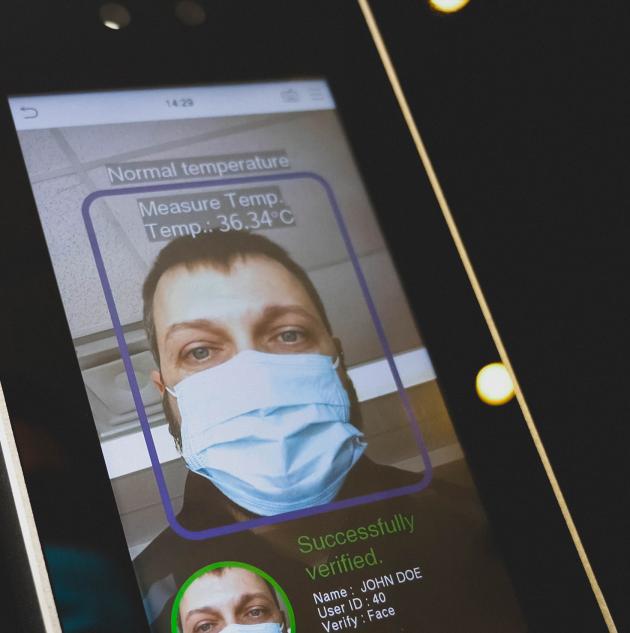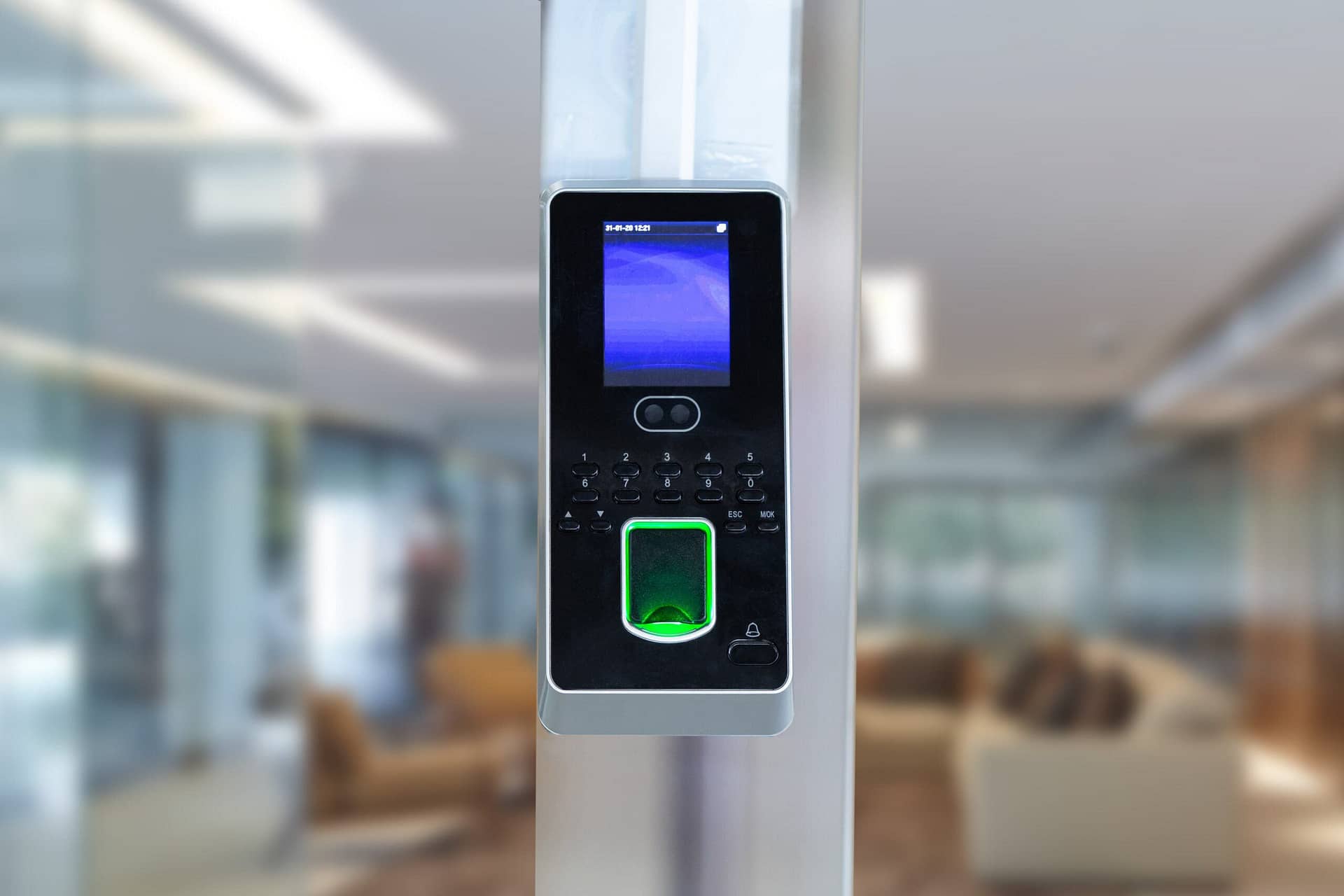Biometric access control—the use of physical characteristics like a fingerprint, retina, or facial scan as a security measure—is in the middle of a profound shift.
Like so much in our world, the COVID-19 pandemic turned the security industry upside down. Before the pandemic, using your fingerprint to unlock a door felt slightly futuristic. But now, the idea of pressing your finger to a public touchscreen seems like a relic of the distant past. Conversely, a scanner that takes your temperature before you get on an elevator might once have seemed invasive but now just seems safe.
The current moment has security companies asking how much of the public’s attitudes toward biometrics are here to stay. Is it worth investing in security solutions that customers might not want after the pandemic? Or are we headed toward a future in which a person’s face is their universal key fob and credit card?
The answers to these questions are still uncertain, but it’s clear that in 2021, biometric access control is part of a larger debate about balancing public health, individual privacy, and security. Security companies need to be aware of these issues so they can adapt accordingly.
COVID-19 Had an Uneven Impact on Biometric Technologies
The COVID-19 pandemic was bad for the forms of biometrics that require contact (namely, fingerprint and palm scans), but it also sparked major interest in contactless biometrics.
A report from ABI Research predicted that 2020 sales of fingerprint devices would drop in the U.S. by $1.2 billion, and the pandemic saw organizations from the NYPD to condo associations rolling back their fingerprint-based procedures. This blow to fingerprint technology is significant since it is the most commonly used form of biometric authentication and the cheapest (a simple scanner sells for $50).
Still, the industry as a whole has been quick to adapt, and contactless forms of biometrics have seen rapid growth. According to one 2020 report, the major trends in the industry are “the rising demand for contactless biometrics and increasing application of biometric system in access control solutions.”
These include:
facial recognition
retina and iris scans
vein recognition
Facial recognition technology has become more widespread during the pandemic, particularly as a way of granting access in highly trafficked locations. For instance, in the spring of 2021, Disney tested out facial recognition for visitors to the Magic Kingdom. Visitors scanned their faces along with their tickets, and the image was then converted into a number that visitors could use to gain entry into the park. Interestingly, this system was compatible with face masks, though Disney abruptly discontinued the program after a few weeks.
The pandemic also added a new dimension to biometric security: scanning people for illness through temperature checks.

Source: STANLEY Security
Security companies around the globe have retrofitted existing biometric access control systems with temperature-sensing devices to help stop the spread of COVID-19. And, because body temperature is not a unique identifier (unlike a retina scan), and, therefore, there’s no reason to store or steal such data, it doesn’t raise the same privacy concerns as other forms of biometric security. It’s hard to say whether mask-proof facial recognition software or automatic temperature checks will stay in fashion after the pandemic, but, regardless, the industry has been impressively quick to add these features.
Biometric Access Control Faces Privacy Concerns
The security benefits of biometrics are undeniable, but customers might be nervous about investing in them out of fear they’ll run afoul of legislation and/or public sentiment. It’s hard to gauge how future legislation will regulate biometrics and just as hard to anticipate if employees will appreciate the heightened security or balk at their most personal information being used as their time card.
As of this writing, multiple states have passed legislation regulating biometrics, requiring companies to obtain consent before collecting this data. Illinois, in particular, has been a leader in establishing a precedent for biometric privacy cases. In two recent cases, the court sided against companies that used biometrics. (One case involved a mother who objected to Six Flags scanning her child’s fingerprint, and the other came from an employee who objected to using her fingerprint to clock in and out.) These local and state laws are still being interpreted, and there’s no sign at present of any federal law on the horizon.
While legislatures attempt to govern the use of biometrics, some industry leaders have taken it upon themselves to self-govern. Most famously, Amazon stopped selling its facial recognition software to police departments, and IBM abandoned the technology altogether, citing concerns over the potential for racial profiling and general misuse. Will these decisions directly affect the average security customer? No. But they will be in the back of their mind as they weigh their options.
Despite public wariness about the use of biometrics, there’s still a general acknowledgment of their usefulness. A 2020 poll found that 75% of Americans are comfortable with facial recognition at airports, and 70% support its use for office security.
Advice to Customers: Proceed with Caution
We don’t yet know how the law and public opinion will evolve regarding biometric security, so the safest bet is to install these systems where they can do the most good and are at the least risk of causing a backlash.
Customers can reserve biometric access control for employees who have explicitly opted in, while maintaining non-biometric security systems for visitors (and employees who don’t opt in). Likewise, biometrics might not make sense for an entire property but can be used for areas that need special protection, like a server room.
Another option is to forego installing biometric sensors and instead let employees (and visitors) scan their mobile devices to access properties. This gives added security (since phones are usually password or biometric protected) without saddling customers with the responsibility for sensitive biometric data.
Ultimately, security sales teams should help customers consider the ROI of biometrics. How much money could they save by not having to account for lost ID badges? How much time could they save through faster entry and exit procedures? Are biometrics a cost-effective way to meet their security obligations? The answers to these questions will determine whether or not biometric access control is a good investment.
Make Biometric Expertise Part of Your Sales Strategy
Biometric access control is still a viable solution for security companies to have in their repertoires and will only become more ubiquitous and less expensive as time goes by. But it’s vital to stay informed about changes in this industry so you can be a trusted advisor to your customers. And it’s equally important to take a surgical approach to sales prospecting, so you can pitch biometrics to the right customers.
Share





